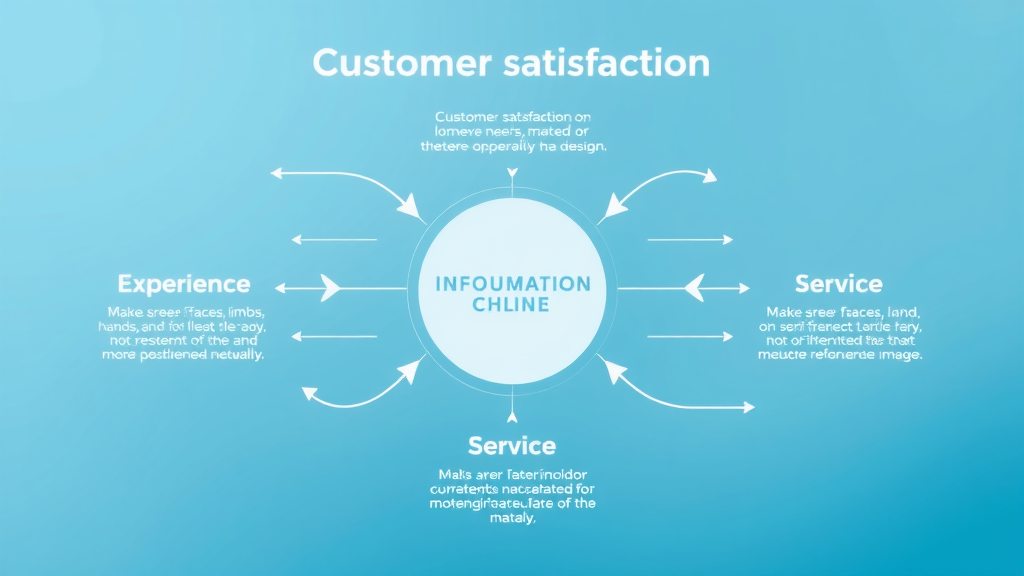- Did you know that 96% of dissatisfied customers never complain directly, but 91% will leave and never return? Improving customer satisfaction isn’t just a nice-to-have—it’s critical for your organization’s reputation and growth. This article presents 25 effective, evidence-based strategies for improving customer satisfaction, including practical tools, impactful statistics, real-life case studies, and actionable steps any business can implement today.

- Why improving customer satisfaction should be your organization’s top priority
- The essential connection between customer satisfaction, customer experience, and customer service
- 25 evidence-based strategies to improve customer satisfaction
- How to measure and act on feedback to boost customer loyalty and retention
- Common mistakes to avoid and actionable tactics to exceed customer expectations every time
- Frequently asked questions about customer satisfaction answered by experts
Why Improving Customer Satisfaction Should Be Your #1 Priority
- Explore why improving customer satisfaction influences retention, referrals, and revenue. See how recent trends in customer service, customer feedback, and the customer journey fit together for a superior customer experience.
Improving customer satisfaction should be at the heart of every business strategy. Studies reveal that companies with higher satisfaction scores enjoy up to 60% greater retention rates, more repeat business, and a steady stream of referrals. Satisfied customers become loyal advocates, telling others about their positive experiences and becoming less sensitive to price, which protects margins and drives growth. In today's world, where a single negative experience can spread fast online, failing to prioritize customer satisfaction can directly impact a brand's reputation.
Modern customer service trends show that the customer journey is no longer linear. Customers expect a seamless experience across all channels—from digital support chats to in-person visits. A focus on customer feedback and proactive service helps organizations identify areas of improvement quickly, ensuring that pain points are resolved before they escalate. When companies make customers feel valued and heard at every touchpoint, they don’t just improve satisfaction; they boost customer loyalty, retention, and revenue over the long term.
Customer Satisfaction vs. Customer Experience vs. Customer Service: Understanding the Links
- Analyze the interconnections between customer satisfaction, customer experience, and customer service. See how each impacts the other and the role they play in improving customer satisfaction.
While often used interchangeably, customer satisfaction , customer experience , and customer service are distinct yet interconnected concepts. Customer service refers to the support and guidance provided when a customer interacts with a business. It is a crucial touchpoint but only one part of the entire customer experience , which includes every interaction a customer has with your brand, from browsing your website to receiving post-purchase follow-up. Customer satisfaction is the measure of how well these combined experiences meet or exceed expectations.
A stellar support team can resolve issues efficiently—a vital element of the journey—but poor product usability or confusing policies can still drag down overall satisfaction. On the other hand, investing in an intuitive knowledge base empowers customers to solve problems on their own, enhancing both their experience and their view of your service quality. The synergy between these components shapes not just the satisfaction score but also determines whether customers become repeat buyers or detractors.

| Aspect | Definition | Goal | Key Metrics |
|---|---|---|---|
| Customer Satisfaction | The degree to which a product or service meets customer expectations | Measure & improve satisfaction levels | CSAT, NPS, CES, satisfaction score trends |
| Customer Experience | All perceptions and emotions from every interaction with a brand | Optimize the entire customer journey | Customer feedback, retention rates, journey mapping |
| Customer Service | Direct support during service interactions | Resolve issues & ensure satisfaction | First response time, resolution rate, feedback scores |
Top 25 Proven Methods for Improving Customer Satisfaction
- Respond Promptly to Every Customer Inquiry
- Personalize Every Customer Experience
- Train Your Support Team for Excellence
- Gather and Analyze Customer Feedback
- Act on Feedback to Improve Customer Satisfaction
- Map and Optimize the Customer Journey
- Exceed Customer Expectations Consistently
- Use CSAT Surveys to Measure Customer Satisfaction
- Empower Employees to Solve Issues Quickly
- Streamline the Knowledge Base for Self-Service
- Offer Omnichannel Customer Service
- Leverage Social Media Responsively
- Design Frictionless Digital Experiences
- Create Customer Loyalty Programs
- Encourage Transparent Internal Communication
- Monitor and Improve Customer Lifetime Value
- Focus on Product or Service Reliability
- Proactively Address Issues Before They Escalate
- Use Technology to Automate Routine Requests
- Recognize and Reward Loyal Customers
- Coach Teams to Show Empathy and Patience
- Educate Customers with Tutorials and Guides
- Communicate Clear Return and Refund Policies
- Gather Insights from Negative Reviews
- Regularly Review and Update Customer Service Touchpoints

Each of these strategies is rooted in real-world results. For example, a fast response to support questions can raise satisfaction scores by up to 25%. Personalizing the customer experience with tailored recommendations turns first-time buyers into loyal customers . Comprehensive support team training ensures consistent, high-quality interactions across all channels. Tools like the CSAT survey and advanced analytics let you measure customer satisfaction and identify pain points proactively.
Companies also improve customer satisfaction by making the customer journey seamless—enabling fast resolutions via a robust knowledge base , leveraging social media for quick responses, and exceeding expectations through unexpected perks or loyalty rewards. Empowering every team member to solve issues, proactively seeking customer feedback , and closing the feedback loop ensure a continuous cycle of improvement. These proven methods, when put into daily practice, consistently raise retention rates, satisfaction levels, and ultimately, business growth.
Examples: How Top Brands Improve Customer Satisfaction
- Discover how leading companies deliver exceptional customer experiences, gather customer feedback, and adapt product or service offerings for success.
Leading brands like Amazon and Zappos have set new industry standards by obsessing over customer experience and rapidly collecting customer feedback . Amazon’s frictionless return policy and responsive support team have helped it retain one of the highest satisfaction scores in e-commerce. Zappos empowers every employee to solve customer issues, even if it means extra time or resources, creating lifelong loyal customers .
Starbucks gathers daily feedback through its app, identifying pain points and rolling out improvements across thousands of stores. Apple routinely maps every customer journey touchpoint, ensuring streamlined in-store service, quick device swaps, and consistent digital support. These companies demonstrate that investing in the customer’s voice, training teams for empathy, and making data-driven changes not only improve customer satisfaction but lead to industry dominance.
"Your most unhappy customers are your greatest source of learning." – Bill Gates
How to Measure Customer Satisfaction Effectively
- Dive into practical approaches: CSAT survey best practices, real-time customer feedback mechanisms, and measuring customer satisfaction using NPS and CES scores.
Measuring customer satisfaction is essential for identifying what works and spotting areas for improvement. The CSAT survey (Customer Satisfaction Score) is among the most widely used methods, asking customers to rate their experience on a scale, often right after a service interaction. Meanwhile, the NPS (Net Promoter Score) measures the likelihood a customer would recommend your business—a key driver of organic growth. The CES (Customer Effort Score) evaluates how easy it was for a customer to get help or complete a task.
Best-in-class organizations deploy a mix of these tools to gain valuable insights from every stage of the customer journey . Real-time dashboards and mobile surveys allow companies to address negative feedback before it becomes public. This proactive approach not only boosts satisfaction levels but also helps improve your customer service processes, ultimately leading to lasting customer loyalty and higher retention rates.
| Metric | What It Measures | Question Example | Benefits | Limitations |
|---|---|---|---|---|
| CSAT | Customer’s satisfaction with a specific interaction or product | “How satisfied were you with your recent purchase?” (1–5 scale) | Immediate feedback, actionable | Single snapshot, may miss overall sentiment |
| NPS | Likelihood of recommending the brand | “How likely are you to recommend us?” (0–10 scale) | Predicts loyalty/word-of-mouth | No context for low scores |
| CES | Ease of customer completing a task | “How easy was it to solve your issue?” (1–7 scale) | Highlights friction points | Less emotional nuance |

Common Mistakes Businesses Make When Trying to Improve Customer Satisfaction
- Ignoring customer feedback
- Over-promising and under-delivering
- Failing to train the support team
- Neglecting the customer journey
- Inconsistently measuring customer satisfaction

Many businesses inadvertently sabotage their efforts to improve customer satisfaction by overlooking feedback from customers or delaying their responses. Ignoring negative feedback or acting only on positive comments blinds companies to real pain points. Promising more than you can deliver erodes trust quickly, while failing to adequately train the support team leads to inconsistent service and frustration.
Additionally, some organizations concentrate only on specific interactions and neglect the overall customer journey . Inconsistent use of satisfaction measurement tools like the CSAT survey or NPS leads to gaps in understanding, making it hard to identify trends or improve customer satisfaction over time. Regularly reviewing and updating customer service processes is crucial for preventing these common mistakes from undermining progress.
How to Avoid These Pitfalls and Maintain High Levels of Customer Service
- Proven strategies to sustain continuous improvement by listening, adapting, and empowering teams to consistently improve customer satisfaction.
To avoid these traps, build a customer-centric culture where everyone is empowered to address customer needs. Regularly solicit and act on customer feedback , using surveys, real-time dashboards, and social channels for a full view of satisfaction levels. Make it a priority to retrain your support team on empathy, responsiveness, and best practices in customer care as your business grows.
Consistency is key—track satisfaction scores and touchpoints across the entire customer journey , not just isolated events. Embrace mistakes as learning opportunities, and encourage transparent communications about what’s working and what needs improvement. This approach ensures you not only maintain but steadily improve customer satisfaction over time, supporting long-term loyalty and growth.
"If you do build a great experience, customers tell each other about that. Word of mouth is very powerful." – Jeff Bezos
Key Statistics That Highlight the Importance of Improving Customer Satisfaction
- List impactful stats on customer retention, loyalty, and the cost of acquiring new vs. retaining existing customers. Support each stat with a source for credibility.

- 96% of dissatisfied customers don’t complain directly, but 91% will leave and never return
- Increasing customer retention by just 5% can boost profits by 25–95%
- Acquiring a new customer is 5–25x more expensive than retaining an existing one
- Customers who rate companies highly on satisfaction are 80% more likely to become repeat buyers
- Word-of-mouth from satisfied customers drives 2x more sales than paid advertising
These statistics reinforce why improving customer satisfaction pays for itself. High satisfaction translates to greater customer loyalty , lower marketing costs due to referrals, and more stable streams of revenue. Simple changes across the customer journey —from better customer service to streamlined feedback processes—can dramatically elevate your satisfaction levels and overall profitability.
By focusing on these critical metrics and benchmarks, you’ll be able to set priorities, track progress with accuracy, and celebrate wins as your retention rates and satisfaction scores rise. Success breeds more success—year after year.
What Are the Most Effective Tactics to Improve Customer Feedback Systems?
- Implementation tips for closing the feedback loop and gathering meaningful customer insights.

To improve customer satisfaction , a robust feedback system is essential. Start by simplifying the way you collect customer feedback —use short, targeted surveys via email, SMS, or your app immediately following key interactions. Automate requests for reviews at every touchpoint along the customer journey to maximize response rates. Intelligent analytics can then identify areas needing improvement by surfacing patterns of negative feedback or recurring pain points.
The most effective tactic is to close the feedback loop —reach out to customers who've shared input (especially those with concerns), address their issues, and communicate the resulting changes. This action reassures customers that their voice matters, transforming a potential detractor into a loyal advocate. Frequent internal reviews of both qualitative and quantitative feedback allow you to make fast, meaningful adjustments that reinforce your brand’s commitment to customer service and satisfaction.
Top Ways to Exceed Customer Expectations Every Time
- List actionable ways to surprise and delight customers to deepen satisfaction and loyalty.

Surpassing customer expectations consistently is what transforms satisfied buyers into loyal customers . Offer unexpected bonuses such as free samples, discounts, or personalized thank-you notes to surprise your customers after their purchase. Fast-tracking the resolution of support requests—sometimes even before the customer asks—shows proactive care. Seasoned companies also host loyalty programs that reward not just purchases, but referrals and social shares, deepening overall engagement.
Another powerful tactic is anticipating your customer’s needs before they voice them. Send timely reminders, helpful content, or video tutorials based on their history and preferences. Make it easy to provide feedback and demonstrate frequent, visible improvements that directly respond to previous suggestions. These thoughtful touches, aligned with a seamless customer experience , signal that your business truly values each relationship.
People Also Ask: How do you increase customer satisfaction?
- To increase customer satisfaction, focus on prompt communication, personalized interactions, thorough post-purchase support, easy complaint resolution, and actively gathering customer feedback to drive continuous improvement.
The best way to increase customer satisfaction is to be accessible and responsive at every touchpoint. Deliver tailored solutions, follow up after each transaction, and streamline issue resolution to minimize frustration. Implementing automated surveys and easy feedback channels will reveal pain points and opportunities, empowering you to make ongoing improvements and delight your customers.
People Also Ask: What are the three C's of customer satisfaction?
- The three C’s of customer satisfaction are Consistency, Communication, and Commitment. Businesses that excel at these create value and trust at every interaction.
Consistency means providing the same high level of service every time. Communication involves keeping customers informed and engaged throughout the customer journey . Commitment is your company’s dedication to placing customer needs first and following through on promises—these three C’s build trust and foster lasting customer loyalty.
People Also Ask: What are the 5 basic levels of customer satisfaction?
- The five levels: 1) Dissatisfaction, 2) Adequate, 3) Satisfaction, 4) Delight, 5) Loyalty. Moving customers towards delight and loyalty should be a core goal in every strategy to improve customer satisfaction.
Every interaction positions your customer somewhere on the satisfaction scale. The aim is to move them from basic satisfaction to delight and ultimately loyalty , where they become vocal brand advocates. Understanding where your customers currently stand shapes more targeted improvement strategies and allows you to celebrate progress as you raise overall satisfaction levels.
People Also Ask: How do you solve poor customer satisfaction?
- Solving poor customer satisfaction requires swift attention to issues, addressing root causes, retraining staff as needed, and using customer feedback to make ongoing improvements.
Start by acknowledging and resolving complaints quickly and openly. Analyze customer pain points to uncover systemic causes, then update policies, processes, or product features responsibly. Continuous staff training and regular use of customer satisfaction surveys help maintain high service standards and prevent recurring dissatisfaction.
Frequently Asked Questions on Improving Customer Satisfaction
- How often should you measure customer satisfaction? What is the best way to gather customer feedback? How does customer loyalty relate to customer satisfaction? What are the top customer satisfaction KPIs?
How often should you measure customer satisfaction? Ideally, measure customer satisfaction regularly—after every significant interaction, quarterly, and annually to track trends, benchmark progress, and respond to real-time issues.
What is the best way to gather customer feedback? Use short, focused surveys (CSAT, NPS, CES), online reviews, and in-person interviews at multiple stages of the customer journey. Leveraging feedback tools embedded in your support channels yields the most actionable insights.
How does customer loyalty relate to customer satisfaction? High satisfaction is a prerequisite for loyalty; satisfied customers are more likely to buy again, recommend your brand, and defend it online—ultimately boosting retention rates and reducing marketing costs.
What are the top customer satisfaction KPIs? Focus on CSAT scores, NPS, CES, first response/resolution time, retention rates, and average customer lifetime value. Tracking these KPIs ensures you can reliably improve customer satisfaction over time.
Top Takeaways to Boost Customer Satisfaction in Any Organization
- Summarize critical action steps: respond quickly, personalize experiences, empower support teams, track feedback diligently, and commit to ongoing customer-centric changes.
The key to improving customer satisfaction is to act deliberately and consistently: respond to inquiries fast, create memorable and personal experiences, invest in the right training for your support team , analyze feedback, and implement changes proactively. Make customer-centricity your organization’s core value for lasting results.
Ready to Improve Customer Satisfaction? Start Building Your Custom Review Strategy Now
- Tired of being overlooked online because of weak or missing reviews? Let us help you implement a custom review strategy that works. Book your free consultation today!
 Add Row
Add Row  Add
Add 




Write A Comment